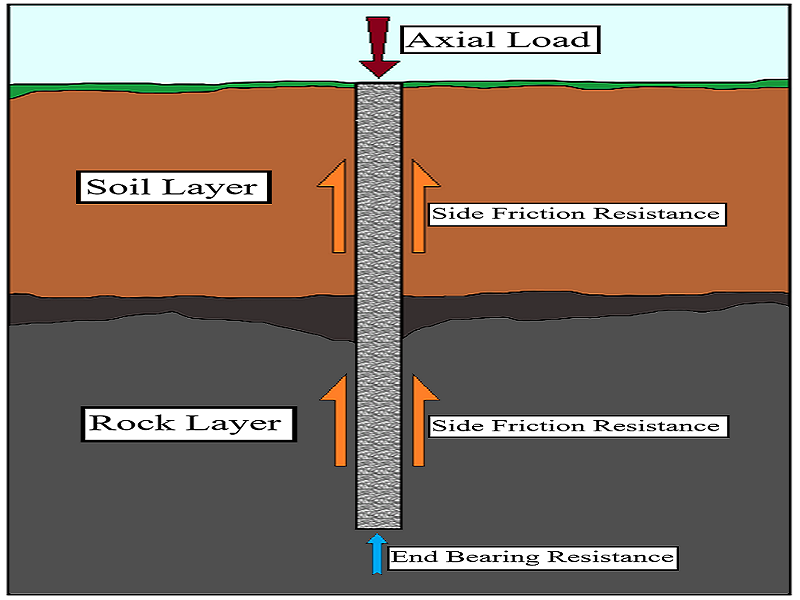Side Resistance of Drilled Shafts Socketed into Rocks for Serviceability and Ultimate Limit States
DOI:
https://doi.org/10.46604/aiti.2020.4155Keywords:
drilled shaft, socketed into rock, side resistance, statistical analysisAbstract
This study evaluates the analysis models of side resistance in rock sections by utilizing a wide variety of load test data. Available analytical models including the empirical adhesion factor versus the rock’s uniaxial compressive strength and its root are analyzed and compared statistically to determine the optimum relationships. The interpretation criteria for the L1 and L2 methods are used to analyze the load test results for serviceability and ultimate limit states, respectively. The analysis results show that the relationship model with the empirical adhesion factor versus the root of the rock’s uniaxial compressive strength exhibits better correlation than the one with the rock’s uniaxial compressive strength. Moreover, the general coordinate axes regression equation demonstrates better reliability than the semi-logarithmic and full logarithmic axes equations for both limit states. Based on these analyses, specific design recommendations for the side resistance of drilled shafts socketed into rocks are developed and provided with the appropriate statistics to verify their reliability.
References
C. V. Stas and F. H. Kulhawy, “Some observations on undrained side resistance of drilled shafts,” Foundation Engineering, Current Principles and Practices, ASCE, pp. 1011-1025, 1984.
Y. J. Chen and F. H. Kulhawy, “Case history evaluation of drilled shafts behavior,” Electric Power Research Institute, Palo Alto, Report TR-104601, p. 356, 1994.
Y. J. Chen and F. H. Kulhawy, “Evaluation of undrained side and tip resistances for drilled shafts,” Proc. Soil and Rock America, vol. 2, pp. 1963-1968, 2003.
M. C. Marcos and Y. J. Chen, “Evaluation of side resistance of driven precast concrete piles,” Materials Science and Engineering, IOP, vol. 658, no. 1, 012005, 2019.
M. C. Marcos, and Y. J. Chen, “Applicability of various load test interpretation criteria in measuring driven precast concrete pile uplift capacity,” International Journal of Engineering and Technology Innovation, vol. 8, no. 2, pp. 118-132, 2018.
F. H. Kulhawy and R. E. Goodman, Foundation in rock, ground engineers reference book, Butterworth and Co. Ltd., 2005.
P. Hooley and S. R. L. Brooks, “The ultimate shaft frictional resistance mobilized by bored piles in overconsolidated clays and socked into weak and weathered rock,” The Engineering Geology of Weak Rock, Balkema, pp. 447-455, 1993.
American Association of State Highway and Transportation Official (AASHTO), Standard Specifications for Highway Bridges, 1992.
R. G. Horvath, T. C. Kenney, and P. Kozicki, “Methods of improving the performance of drilled piers in weak rock,” Canadian Geotechnical Journal, vol. 20, no. 4, pp. 758-772, 1983.
C. S. Ku, J. Weng, X. Liu, and X. Lin, “Study on side resistance of soft rock foundations,” Proc. Rock Engineering Symposium, Tamsui, pp. 224-231, 2007.
Z. Y. Yang, J. Q. Shiau, J. Ching, Y. S. Lee, and C. J. Chen, “Side resistance of pile socketed into rock in Taiwan area,” Proc. Rock Engineering Symposium, Kaohsiung, pp. 75-83, 2010.
C. C. Hsiao, “Evaluation of side resistance for drilled shafts socketed into rocks,” Master Thesis, Department of Civil Engineering, Chung Yuan Christian University, 2018.
A. Hirany and F. H. Kulhawy, “Interpretation of load tests on drilled shafts: axial compression,” Foundation Engineering: Current Principles & Practices (GSP22), ASCE, New York, pp.1150-1159, 1989.
Y. J. Chen and Y. C. Fang, “Critical evaluation of compression interpretation criteria for drilled shafts,” Journal of Geotechnical and Geoenvironmental Engineering, ASCE, vol. 135, no. 8, pp. 1056-1069, 2009.
C. Tang, K. K. Phoon, and Y. J. Chen, “Statistical analyses of model factors in reliability-based limit state design of drilled shafts under axial loading,” Journal of Geotechnical and Geoenvironmental Engineering, ASCE, vol. 145, no. 9, pp. 04019042-1-19, 2019.

Published
How to Cite
Issue
Section
License
Submission of a manuscript implies: that the work described has not been published before that it is not under consideration for publication elsewhere; that if and when the manuscript is accepted for publication. Authors can retain copyright in their articles with no restrictions. is accepted for publication. Authors can retain copyright of their article with no restrictions.
Since Jan. 01, 2019, AITI will publish new articles with Creative Commons Attribution Non-Commercial License, under The Creative Commons Attribution Non-Commercial 4.0 International (CC BY-NC 4.0) License.
The Creative Commons Attribution Non-Commercial (CC-BY-NC) License permits use, distribution and reproduction in any medium, provided the original work is properly cited and is not used for commercial purposes.







